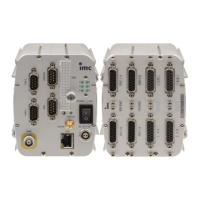© 2018 imc Test & Measurement GmbH
imc C-SERIES - Manual, Version 4 R 3 - 2018-10-19
47Measurement types
4.6.3.2 Mode (events-counting)
Events
The event counter counts the sensor pulses which occur during a single time interval (differential
event counting). The interval corresponds to the sampling time set by the user. The maximum event
frequency is about 500 kHz.
An event is a positive edge in the measurement signal which exceeds the user-set threshold value.
The derivative quantities displacement and angle measurement have the following settings:
·
Choice of one-signal and two-signal encoder
·
Start of measurement with or without "Zero impulse"
·
Number of pulses (per unit)
Distance
Distance (differential)
Path traveled within one sampling interval. For this purpose, the number of pulses per meter must
be entered.
Distance (absolute)
Absolute distance. The differential distance measurement is converted to the absolute distance. By
taking the zero impulse (the counter with no zero impulse should not be selected) into account,
the absolute distance position is determined and indicated. Otherwise, the distance value is
assumed to be 0° when the measurement begins.
Angle
Angle (differential)
Angle traveled within one sampling interval. For this purpose, the number of pulses per revolution
must be entered. The absolute angle can be calculated in imc Online FAMOS or determined by the
mode Angle(abs).
Angle (absolute)
The differential angle measurement is converted to the absolute angle. By taking the zero impulse
(the counter with no zero impulse should not be selected) into account, the absolute angle
position is determined and indicated. Otherwise, the angle value is assumed to be 0° when the
measurement begins.
Angle (sum)
The differential angle measurement is converted to the cumulative angle. In the process, any zero
pulse is evaluated only one time. For this reason, angles which are > 360° are possible.
When using incremental encoder modules that work internally with a 16-bit counter, encoders with
high pulse rates can lead to overflows. The count is always carried out with sign: 2
16
= 65536, i. e.
±
32767. With two-signal encoders the pulse number is quadrupled internally and leads to a maximum
number of pulses per revolution of 8192. For encoders with more pulses per revolution, the hardware
must have a 32 bit counter, e. g. imc CANSASfit-ENC6, otherwise an event count must be carried out
instead and converted with imc Online FAMOS.
46
46

